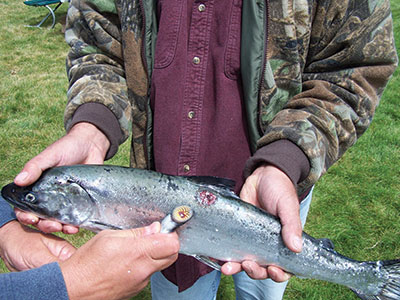
Overview: The Invasive Sea Lampreys in Lake Erie
The story of the sea lamprey in Lake Erie is a fascinating, though troubling, chapter in the history of the Great Lakes ecosystem. These parasitic creatures, measuring 12 to 18 inches long, have managed to thrive for over 340 million years. However, their long tenure on Earth takes on a new and worrisome tone in the modern era when they invade new territories and unsettle the local fish populations. In this editorial, we take a closer look at the origin, behavior, and impact of sea lampreys, along with discussions on control methods and the importance of public education in managing this invasive species. By poking around their life cycle, feeding patterns, and the measures used to control their spread, we can better understand both the challenges and the potential opportunities for restoring balance to our beloved aquatic ecosystems.
Parasitic Origins and a Survival Story Spanning Millennia
One of the most astounding aspects of the sea lamprey is its resilience. These creatures are native to the Atlantic Ocean, yet they entered the Great Lakes via sea-going ships long ago. Their ability to latch on to host fish and siphon off blood and other body fluids is nothing short of extraordinary. While in their native environment, lampreys and fish have co-evolved, allowing the parasite to live off its host without necessarily causing its death; the situation is very different in Lake Erie and other Great Lakes, where the absence of this long shared history means that lampreys are far more destructive.
The tough survival skills and primitive design of the sea lamprey make it an almost otherworldly living relic. Their body plan has remained essentially unchanged through twists and turns of evolution, surviving even four major extinction events. Yet, in the modern context, they present a number of tangled issues for our local fish, posing a critical threat to species that were once abundant in the lake.
Impacts on Great Lakes Fish Populations
The key concern with sea lampreys in Lake Erie is their significant impact on the native fish populations. Species such as Lake Erie steelhead, brown trout, and especially lake trout are particularly vulnerable to these parasitic predators. A single lamprey, during its 12- to 18-month feeding cycle, can deal a fatal blow to multiple fish. When you consider the cumulative effect, the consequences are both intimidating and nerve-racking for local fishermen and conservationists alike.
Below is a list highlighting some of the affected fish species:
- Lake Trout
- Brown Trout
- Steelhead
- Walleye (to a lesser extent)
Such a list shows the varied ways the sea lamprey exerts pressure on the ecosystem. With every attack, they not only reduce fish numbers but also alter the balance of the entire aquatic environment.
Life Cycle: The Hidden Details of Sea Lamprey Behavior
Understanding the little details of the sea lamprey’s life cycle is essential when considering its broader environmental impact. Adult lampreys migrate into freshwater streams where they build crescent-shaped nests out of rocks to spawn. After spawning, the adult lampreys die, a process that in itself is not dangerous. However, the real threat starts with the larvae.
After the eggs hatch, the lamprey larvae—known as ammocoetes—begin a long, hidden stage of their life spent burrowed in soft sediment. It is here that they filter-feed on micro-organisms. Over several years, they slowly undergo metamorphosis, gradually developing eyes and a fully formed, suction-cupped mouth equipped with barbed teeth. Once matured, these juveniles move into the open lake, where they resume their parasitic feeding habits on other fish. After a feeding period that lasts well over a year, each lamprey returns to a freshwater stream to spawn once again, repeating the cycle.
This life cycle is laid out below in a simplified table for clarity:
| Stage | Description |
|---|---|
| Adult Migration & Spawning | Adults migrate into streams, build nests, spawn, then die. |
| Larval Stage (Ammocoetes) | Newly hatched larvae burrow into soft sediment and feed on micro-organisms. |
| Metamorphosis | Larvae undergo transformation, developing eyes and a suction-cupped mouth with sharp teeth. |
| Juvenile Stage | Mature lampreys migrate to the open lake and begin parasitic feeding on fish. |
| Return & Repeat | After a feeding period of 12-18 months, they return to streams to spawn, and the cycle repeats. |
The detailed progression of their life cycle highlights not only the resilience of sea lampreys but also reveals the complicated pieces of their existence—components that are both fascinating and full of problems for the local ecosystem managers who must figure a path through these issues.
Feeding and Attachment: The Nitty-Gritty of Parasitic Behavior
At the heart of the sea lamprey’s threat is its unique feeding mechanism. Resembling eels in appearance, these creatures are not closely related to eels. Instead, the defining feature that sets them apart is the large suction-cupped mouth, lined with sharp, horn-shaped teeth and a rasping tongue that acts like a built-in saw. When a lamprey attaches to a host fish, it digs its teeth into the flesh, securing a tight grip before it begins to feed.
In effect, the lamprey secretes an enzyme that prevents the fish’s blood from clotting, similar to the way a leech works on its host. Once attached, the lamprey starts to gnaw through the scales and skin of the fish, extracting not just the blood, but other bodily fluids as well. This process is both intimidating and nerve-racking to witness—especially when it occurs in a natural setting where conservationists are struggling to protect endangered fish populations.
For those interested in understanding the feeding process in a structured way, here’s a step-by-step bullet list outlining the feeding sequence:
- Attachment: Lamprey uses its suction-cupped mouth to latch on to the host fish.
- Securing Grip: The sharp, horn-shaped teeth and rasping tongue help to secure the lamprey’s position on the fish.
- Enzymatic Secretion: The lamprey releases enzymes that prevent blood clotting.
- Feeding: It then slowly consumes the blood and other fluids while remaining attached.
- Severely Weakened Host: Over time, the host fish is weakened considerably, making it vulnerable to predation, disease, or other complications.
Each of these steps demonstrates a tactical, almost clinical method that underscores why lampreys have continued to thrive despite being so full of problems for their hosts.
Control Measures: Effective Management Strategies for Sea Lampreys
Efforts to manage and control the sea lamprey population in the Great Lakes depend heavily on the use of lampricides—a chemical treatment aimed specifically at killing lamprey larvae in freshwater streams. These treatments have been a mainstay of ecological management for many years, effectively reducing the number of larvae before they have a chance to metamorphose and wreak havoc.
However, this approach is not without its own set of tangled issues. For one, the program relies on consistent, subsidized funding. Without this financial backing, the lampricide treatments could fall into disrepair, potentially allowing lamprey populations to surge unchecked. Furthermore, while the chemicals are designed to target the lamprey larvae specifically, there is always the possibility of accidental collateral damage to other aquatic life forms.
It can be useful to visualize the control measures in a compact table:
| Management Aspect | Details |
|---|---|
| Chemical Control | Use of lampricides to target lamprey larvae in streams. |
| Funding Dependency | Reliant on continuous, subsidized funding for consistent application. |
| Environmental Impact | Chemicals are designed to minimize harm to non-target species, though risks remain. |
| Monitoring and Research | Ongoing studies evaluate the efficiency and long-term impacts of treatments. |
The management strategy, while effective on many fronts, is also a reminder of the complicated pieces involved in solving environmental issues. The combination of high-stakes funding, potential ecological side effects, and the sheer persistence of the lampreys makes it a daunting—and at times nerve-racking—challenge for those charged with finding a path forward.
Public Demonstrations: Learning Through Hands-On Experience
One of the notable efforts to educate the public about sea lampreys occurred during a recent demonstration at the Northern Chautauqua Conservation Club Walleye Derby. Here, experts from the Great Lakes Fishery Commission set up an interactive display featuring live sea lampreys in a small aquarium. During this demonstration, a technician allowed a lamprey to attach to his hand—a vivid, first-hand experience that turned abstract concerns into tangible, if somewhat intimidating, reality for attendees.
Events like these provide an invaluable opportunity to show the public the subtle details of parasitic behavior up close. By witnessing the lamprey in action, observers are better able to understand the direct implications of these creatures on local fish populations and the broader ecosystem. Moreover, such events serve as a reminder of the importance of scientific research and public engagement when tackling environmental challenges.
Key aspects of these public demonstrations include:
- Real-Life Interaction: Participants get a first-hand look at the lamprey’s feeding mechanism.
- Educational Outreach: Experts explain the lifecycle and impact of sea lampreys, breaking down the confusing bits into easier-to-understand segments.
- Catalyst for Discussion: These displays foster conversation about invasive species and the need for more sustainable management practices.
While there is an element of risk in showcasing living parasites, the experience demystifies their behavior and encourages a greater sense of urgency regarding their control. Many in attendance found it both enlightening and a bit off-putting, as it forced them to confront the reality of an invasive species that is both ancient and alarmingly destructive.
Funding and Policy: Charting a Course Through Financial Twists and Turns
Any discussion about sea lampreys would be incomplete without an examination of the policy and funding challenges associated with invasive species management. Funding remains a super important aspect of the control program. Without sustained financial support, initiatives like the lampricide treatment program may struggle to maintain their effectiveness over the long term.
There are several tangled issues in this arena:
- Budget Constraints: Limited public funds mean that invasive species management often competes with other pressing needs.
- Political Challenges: Policy shifts can lead to guarantees or cutbacks in funding, directly affecting program continuity.
- Long-Term Planning: Effective management requires a strategic, long-term view that may clash with short-term fiscal pressures.
In many ways, the financial challenges of managing sea lampreys mirror the broader climate of environmental policy issues across the United States. There is always a tension between the immediate costs of prevention and control and the long-term benefits of a healthy ecosystem. As such, it is essential for policymakers, stakeholders, and the public to work together in finding solutions that are both economically feasible and ecologically sound.
Educational Outreach and Community Involvement
Community engagement is a key component in addressing the issues posed by sea lampreys. Educational outreach programs educate local anglers, conservation groups, and concerned citizens about the fine points of lamprey behavior and the subtle details of control measures. By providing a clearer picture of what these invasive species do and why controlling them is critical, the outreach efforts help community members become active participants in the process.
The benefits of robust community engagement include:
- Increased Awareness: Enhanced public knowledge translates into wider support for invasive species control programs.
- Volunteer Efforts: Engaged citizens can assist with monitoring and research efforts, easing the burden on state and federal agencies.
- Local Partnerships: Collaborations between local governments, conservation groups, and community members can lead to more effective and lasting solutions.
Ultimately, when the community works together, they can better manage the tricky parts of invasive species control and ensure that programs remain funded and effective. Educational displays, workshops, and interactive events serve as an excellent platform for making the often intimidating topic of invasive species management accessible and engaging.
Ecological Opportunity: Finding New Paths Amid Environmental Challenges
While the presence of sea lampreys is undeniably a problem, it also opens up avenues for innovative ecological solutions and scientific inquiry. Researchers and wildlife managers are continuously exploring new methods to combat the destructive behavior of these invasive organisms. From refining lampricide formulations to experimenting with environmental modifications that disrupt the lamprey lifecycle, there is a wealth of ongoing work aimed at mitigating their impact.
Some promising areas of research include:
- Biological Control: Investigating natural predators or parasites that might help control lamprey populations without the need for chemicals.
- Behavioral Studies: Gaining a better understanding of lamprey behavior can lead to innovative strategies for management and prevention.
- Habitat Restoration: Enhancing the resilience of native fish populations through habitat improvements can help mitigate the impact of lampreys.
- Technological Advances: Using modern monitoring tools and data science to forecast lamprey migrations and optimize control measures.
While these strategies are still in the research phase, they represent a hopeful shift towards more sustainable and environmentally friendly ways to deal with this invasive species. Such methods would not only address the immediate issues but also pave the way for long-term ecological recovery in Lake Erie and the surrounding Great Lakes.
Managing Public Perception and the Role of Media
The media plays a key role in shaping public understanding of environmental challenges like the sea lamprey invasion. Reporting on invasive species often involves a mix of highly technical details and vivid depictions of nature’s raw power. In doing so, the media can either allay public fears or, conversely, amplify the more nerve-racking and overwhelming aspects of the problem.
Effective communication requires finding a balance between these two extremes. Here are several tips for managing public perception:
- Simplify the Science: Use plain language to explain the tricky parts of lamprey biology and management strategies.
- Highlight Success Stories: Focus on examples where targeted control measures have led to ecological improvements.
- Engage with Experts: Allow scientists and conservationists to offer their insights directly, reducing misinformation.
- Use Visuals: Photographs, demonstrations, and tables can help the public get a clearer picture of the issues involved.
By striking a healthy balance between caution and optimism, public figures and media outlets can help foster a more informed discourse on invasive species management. The goal is to transform what might seem like overwhelming, off-putting challenges into manageable problems that can be tackled with the right combination of expertise, funding, and community support.
Policy Implications and Future Challenges
Policy decisions made at the local, state, and federal levels will have a significant impact on how effectively the sea lamprey problem is addressed in the coming years. Every twist and turn in the funding process matters, as does the willingness of lawmakers to support science-based initiatives. A continued, well-funded lampricide program is super important, yet it is only one piece of the larger puzzle.
Several key policy implications include:
- Long-Term Funding Stability: Establishing a consistent financial baseline is crucial for the success of any invasive species management program.
- Interagency Cooperation: Coordination between various governmental agencies ensures that efforts are unified and efficient.
- Public-Private Partnerships: Collaborative ventures can provide additional resources and innovative solutions to complement government initiatives.
- Regulatory Adjustments: Updated environmental and transportation regulations can help prevent new invasions by hitchhiking species.
As policymakers work to find their way through these tangled issues, they must balance ecological needs with economic realities. It is through thoughtful, well-rounded debate and a willingness to invest in long-term solutions that the challenges posed by the sea lamprey invasion can be met head on.
Conclusion: A Call for Coordinated Action and Continued Research
The saga of the sea lamprey in Lake Erie offers a vivid example of how a single invasive species can upend an entire ecosystem. Over millions of years, these creatures have honed survival skills that allow them to thrive and devastate their host populations in completely unpredictable ways. From the detailed feeding process to the challenges of controlling a population that is both ancient and remarkably efficient, every aspect of the issue is full of problems and complicated pieces that require careful thought and sustained intervention.
Even as we face an environment loaded with issues, there is also a tremendous opportunity for scientific advancement and public education. To genuinely protect the aquatic environments of the Great Lakes, all parties involved—from environmental scientists and policymakers to local fishing communities and educators—must work together. We must be prepared to get into the fine shades of ecological management, steer through the confusing bits of invasive species control, and find practical solutions that blend research with community participation.
This coordinated action is not only critical for preserving our cherished lake trout, brown trout, and other native fish but also for maintaining the balance of the entire ecosystem. Only by embracing both innovation and traditional methods can we hope to mitigate the severe impacts of sea lampreys while laying the groundwork for more resilient future habitats.
In conclusion, the issue of sea lampreys thriving off Lake Erie fish is a multifaceted problem. It melds environmental science, community involvement, economic considerations, and policy challenges into a scenario that is as daunting as it is intriguing. The journey to manage this ancient invader is both nerve-racking and inspiring—a call to action for all of us to step up and take the wheel in preserving our natural resources.
By staying informed, supporting funding for scientific research, and participating in local initiatives, we can all contribute to a future where the natural beauty and ecological balance of places like Lake Erie are maintained despite the relentless persistence of invasive species. It is a shared responsibility that calls for immediate, coordinated effort and unwavering dedication to creating a better, more balanced environment for generations to come.
Originally Post From https://www.observertoday.com/sports/local-sports/2025/08/sea-lampreys-thrive-off-of-lake-erie-fish/
Read more about this topic at
All about invasive sea lamprey
Funding cuts threaten invasive species programs amid …


